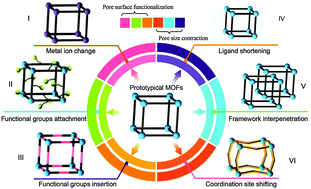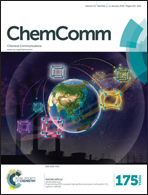Finely tuning MOFs towards high-performance post-combustion CO2 capture materials†
Abstract
CO2 capture science and technology, particularly for the post-combustion CO2 capture, has become one of very important research fields, due to great concern of global warming. Metal–organic frameworks (MOFs) with a unique feature of structural fine-tunability, unlike the traditional porous solid materials, can provide many and powerful platforms to explore high-performance adsorbents for post-combustion CO2 capture. Until now, several strategies for finely tuning MOF structures have been developed, in which either the larger quadrupole moment and polarizability of CO2 are considered: metal ion change (I), functional groups attachment (II) and functional group insertion (III), vary the electronic nature of the pore surface; or targeting the smaller kinetic diameter of CO2 over N2 is focused on: framework interpenetration (IV), ligand shortening (V) and coordination site shifting (VI) contract the pore size of frameworks to improve their CO2 capture properties. In this review, from the viewpoint of synthetic materials scientists/chemists, we would like to introduce and summarize these strategies based upon recent work published by other groups and ourselves.


 Please wait while we load your content...
Please wait while we load your content...